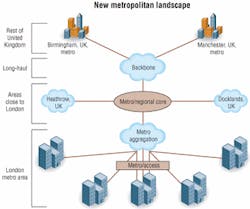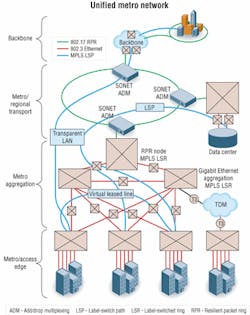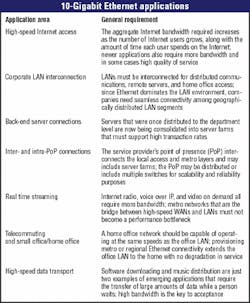Meet the new MAN
That great technology melting pot known as the metropolitan landscape finally comes together.
RICHARD BENWELL, Riverstone NetworksThrough the evolution of Internet networking, most traffic now resides in metropolitan areas, making the MAN the point of service delivery and the key to carrier profitability. With this fundamental shift, carriers are now looking to deploy advanced technologies in the MAN that will enable them to create, deliver, and account for new services. Three new technologies that are gaining popularity for MAN service providers are 10-Gigabit Ethernet (10-GbE), MPLS, and resilient packet ring (RPR).
MPLS and 10-GbE will likely form a major portion of future metro networks, as carriers look to leverage existing network infrastructures and adapt to increased data traffic. 10-GbE and packet-ring networking will be used for Layer 2 data transport, and MPLS will be deployed for traffic engineering and network-level service creation-all united by IP-based routing and applications. Figure 1 shows how a metro network could be deployed in the greater London area.
While each technology on its own will have a significant impact on the future of metro networking, it is equally important to understand how the three technologies will work together and how they will be integrated into future MANs.
While fiber has been widely deployed in the metro core, the remaining bottleneck in the metro-access network continues to be the last mile-the hop of the network that extends to the customer premises. Much has been written about the issues involved in last-mile networking. Nonetheless, it remains clear that the future for high-speed business connectivity increasingly is found in fast Ethernet over fiber or copper at the high end and cable and DSL broadband connectivity at the lower end.RPRs, which will provide substantial enhancements in both efficiency and flexibility over current bidirectional ring topologies, is responding to the growing data traffic in carrier networks. Current data networks have to adapt to TDM networks, which are bandwidth inefficient. Extending LANs designed for data traffic fails to provide the resiliency required in MANs and WANs.
There now exists a need for a resilient data link layer (DLL) optimized for data traffic for optical networks used in LANs, MANs, or WANs. This new DLL must not preclude using existing or future physical layers for optical networks. Packet rings work by assuming that a packet sent on the ring will eventually reach its destination node, regardless of which path was taken around the ring.
RPR technology will grow in importance as the key technology for the centerpiece of the metro-the metro or regional transport core. 10-GbE is less than ideal for handling data traffic on a ring network. In addition, legacy SONET/SDH technology does take advantage of ring topologies but does not handle data traffic efficiently and wastes ring bandwidth, which means RPR technology will play a key role in metro networking.
Need for speed
10-GbE technology enables a familiar network technology to be used in LAN, MAN, and WAN architectures. While several have praised 10-GbE as a revolutionary bandwidth-enhancing technology, it cannot achieve its full potential within telecommunications networks on its own. One companion technology that will enhance 10-GbE is MPLS, which adds desired capabilities at a higher layer (e.g., Layer 2).
One example of how MPLS can enhance 10-GbE technology is to use MPLS in conjunction with Ethernet networks to create private data services and virtual private networks (VPNs). With MPLS capabilities, a 10-GbE network becomes a frame relay (FR)/ ATM replacement technology, allowing both new and incumbent service providers to provide VPN services over low-cost Ethernet networks.
That is done in a manner that extends across core MPLS or ATM networks to provide nationwide or worldwide connectivity. Such services are on nearly every carrier's agenda. Some examples of these newer applications are listed in the Table on page 54.
MPLS: the services keyMPLS is unique in its service-creation capability. When fully implemented on the Internet, MPLS is expected to deliver the quality of service required to adequately support real time voice and video as well as SLAs that guarantee bandwidth.Following in the tradition of the "dumb network," MPLS enables more decisions to be made at the network edge. With several powerful service-creation features that enable carriers to launch new revenue-generating applications such as on-demand bandwidth provisioning, VPNs, and transparent LANs, MPLS also interoperates with and extends the capabilities of existing networks such as ATM, FR, and Ethernet.
Additionally, MPLS can enhance Ethernet in the metro. While the most pervasive legacy of Ethernet's LAN origins is its scale, Ethernet was never designed to operate on complex metro networks. Consequently, its network-level functionality is both limited in scale, capabilities, and network intelligence. Rather than replacing Ethernet, MPLS will enhance it. Ethernet remains an unrivaled transport solution in terms of cost, simplicity, and universality. MPLS adds size, scale, and flexibility to Ethernet. Combining MPLS and Ethernet in the same MAN deployment improves the functionality of Layer 2 networks without sacrificing the speed and simplicity of IP. There are three ways MPLS can be used with GbE or RPR technology to deploy different type of new value-added services:
- IP VPN services. Using an MLPS overlay on an Ethernet or RPR metro network enables service providers to offer IP VPN services that can complement and compete with FR or ATM technology. VPN services are based on a private network configured within a public network. For years, common carriers have built VPNs that appear as private national or international networks to the customer, but physically share backbone trunks with other customers. VPNs enjoy the security of a private network via access control and encryption, while taking advantage of the economies of scale and built-in management facilities of large public networks. Today, there is tremendous interest in VPNs over the Internet, and a huge growth in VPN use is expected.
- Transparent LAN services (TLS). TLS figures to be a major source of incremental revenue for service providers. It refers to a communications service from a local telephone company or common carrier that links remote LANs together. It is transparent because the Ethernet, token ring, or FDDI network is connected directly to the service at both ends, regardless of the technology employed by the carrier in between. The LAN administrator is not responsible for dealing with a different protocol to offer bandwidth guarantees.
- Scaling existing frame relay networks. Carriers who launch Ethernet-based services by building out metro Ethernet/MPLS networks can leverage the same infrastructure to support FR services.
Figure 2 shows how the combination of these MPLS, RPR, and 10-GbE technologies fit together to form the unified metro network of the future. As carriers deploy advanced technologies in the MAN that will enable them to create and account for new services, it is clear that these technologies will become critically important.
Richard Benwell is European marketing director at Riverstone Networks (Santa Clara, CA). He can be reached via the company's Website, www.riverstonenet.com.




